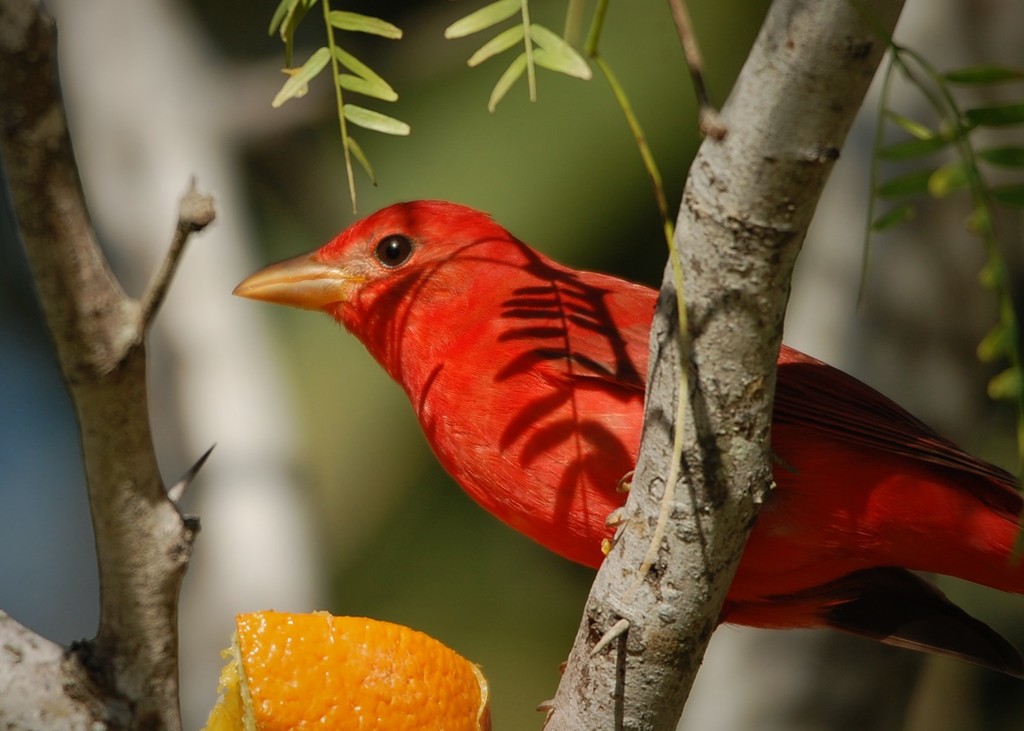by M. Kathy Raines
A bright red bird! And it’s not a cardinal! And it’s not fluttering away at first glimpse!
During April, the peak of spring migration in South Texas, one often spots a summer, scarlet, or, occasionally, a western tanager resting on one of our low branches—to the delight of photographers unable to convince fluttery warblers to strike a pose. We are indeed fortunate hosts. In much of their nesting and wintering grounds, tanagers dwell and hunt so high in the treetops that locals seldom see them.
Though scarlet tanagers—distinguished by the breeding male’s black wings and tail— pass through our state to nest in the Midwest or East, summer tanagers, primarily birds of the Southeast and lower Midwest, nest throughout most of Texas—most commonly in East Texas, but also along the Edwards Plateau and in the Coastal Prairies and Trans-Pecos regions. They once nested in the Valley but haven’t for decades, and they rarely winter here. To his surprise, though, Javier Gonzalez, Naturalist Educator at South Padre Island Bird, Nature Center and Alligator Sanctuary, spotted a summer tanager on the Island during 2022’s Christmas Bird Count. Journeying mainly at night and flying over the Gulf, summer tanagers migrate to and from their southern wintering grounds in flocks of up to thirty.

A male summer tanager wears Crayola-red feathers year-round. While some females, especially elderly ones, sport a reddish wash, most have muted green feathers above, yellowish ones below. Immature tanagers exhibit orange and red splotches among yellow feathers, with some youth resembling females. All have thick bills and dark feet, legs and eyes.

The summer tanager (Piranga rubra) derives its genus name from “Tijepiranga”, a Tupi people’s word for an indeterminate bird. Its species name means “red” in Latin. Though once in the family Thraupidae, North American tanagers—now thought to be more closely related to cardinals than tropical tanagers—occupy the family Cardinalidae. Some dub the summer tanager “summer redbird” or, given its affinity for bees, “red beebird”. In Spanish, it is “piranga roja”, the latter word meaning “red”.
Summer tanagers consume insects, which they snatch from the air—sallying to and from a lofty branch—or glean from vegetation. They also enjoy fruit. During migratory stopovers on the Island, Gonzalez said, “Tanagers love to eat large wasps and carpenter bees,” and they also devour proffered orange halves and fruit from mulberry trees. This tanager snatches a bee or wasp, then slams it against a limb, wiping it against the branch to extract its stinger. Tanagers also tear into wasp nests to devour larvae.
This tanager generally nests from 10 to 35 feet up in edges or gaps in open woods, with East Texas birds constructing nests mainly in pines and assorted deciduous trees, while those in the Hill Country and West Texas, employ willows, cottonwoods, cedar and mesquite trees along streams. The female, sometimes accompanied by her mate, totes materials—stems, bark, spiderwebs, grass and Spanish moss— and constructs a loose, shallow cup nest, usually on the fork of a horizontal branch overlooking an open area. She alone sits on the nest, but both feed the chicks, which hatch in from eight to ten days.
Both brown-headed and bronzed cowbirds—nest predators who drop their eggs in nests of other birds, prompting them to raise their cowbird chicks—prey upon tanagers, who very aggressively chase them off if they can. However, once cowbird eggs have been laid, unwitting tanagers nurture the large, early-hatching adoptees, often at the expense of their own brood.
Normally solitary, a summer tanager may forage with a mate during breeding season. It hops on the ground and bursts through vegetation with fast, direct flight, swerving adeptly when chasing off an intruder. Its tuneful, robin-like song contains some whistled notes. Both sexes make a staccato call of “Pit-ti-tuck.” Males may engage in counter-singing on breeding grounds when competing for turf.
Though vulnerable to deforestation, as well as collisions with towers, populations of summer tanagers have increased somewhat between 1966 and 2019, according to North American Breeding Bird Survey. They have, however, declined in some areas. The oldest known summer tanager, a banded male which was then released, was at least eleven.

